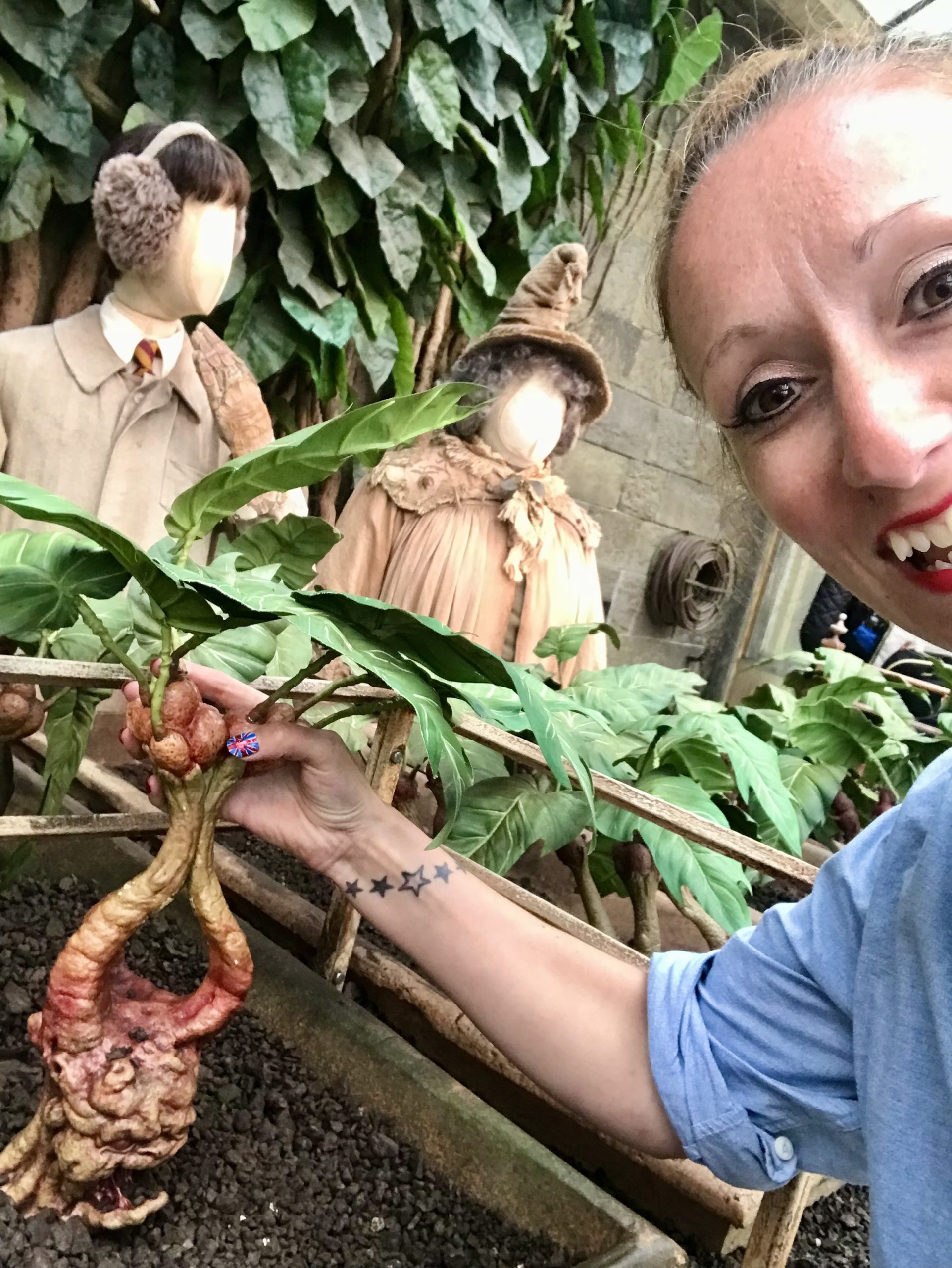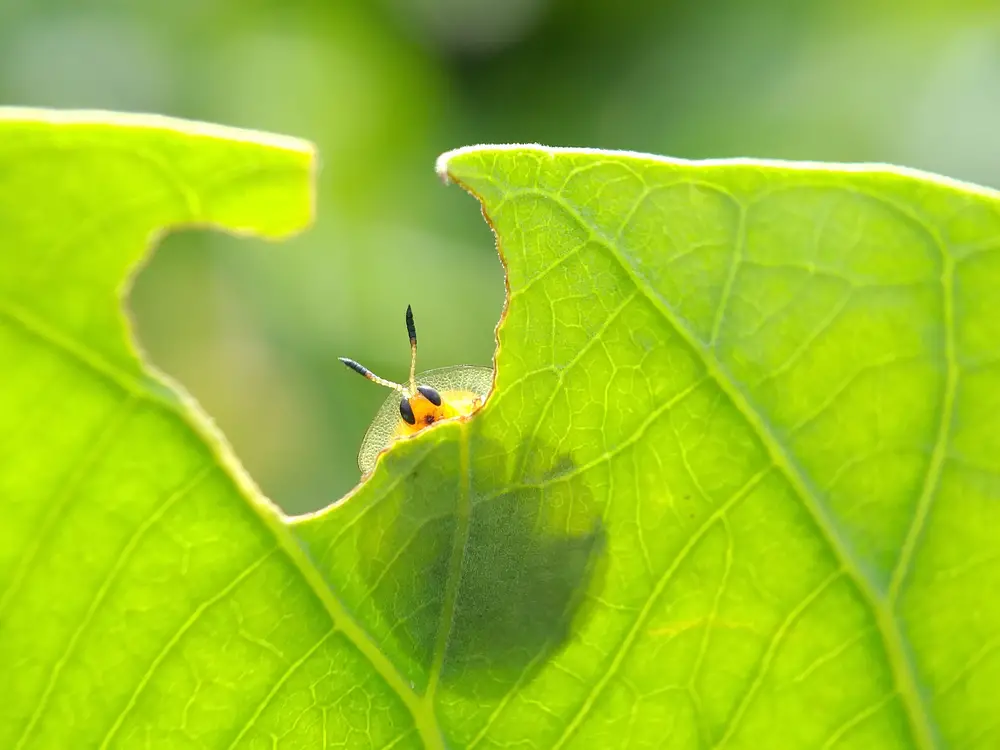Did you know that there are over 400,000 different species of beetles? And the oldest known one existed around 295 million years ago? So, beetle food preferences have been fine-tuned over millennia!
They are the largest order of insects and can be found in every part of the world, except for some arctic regions and the ocean. Beetle feeding habits depend on where they are in the world. They are resilient little critters and can thrive in most climates: hot, cold, dry, humid, swamps, tropics, and deserts – they are not fussy!
So with this amazing amount across the planet, you might wonder: What do beetles eat in gardens? Understanding beetle diets for gardeners is important because we want to know if they are friends or foes.
Oftentimes, when we think of them we assume they are going to be problematic. But, it is important to note that there are many beneficial types in our gardens. Some are prolific pollinators and amazing predators. So make sure you don’t think that they are all pests.
In this article, we’ll explore some of the most common garden beetles and their food, how they impact gardens, and find out if you want to attract them or, if not, how to manage them in your garden.
What Do Beetles Eat?
The general feeding habits of beetles really depend on the type. Some love to munch on fresh green leaves, some like nectar, and others are carnivorous.
Types Of Beetles And Their Diets
The differences in diet among beetle species is significant. Here, we’ll break it down into some common categories: garden, wood-boring, and predatory.
Garden Beetles
Ladybugs (Coccinellidae)
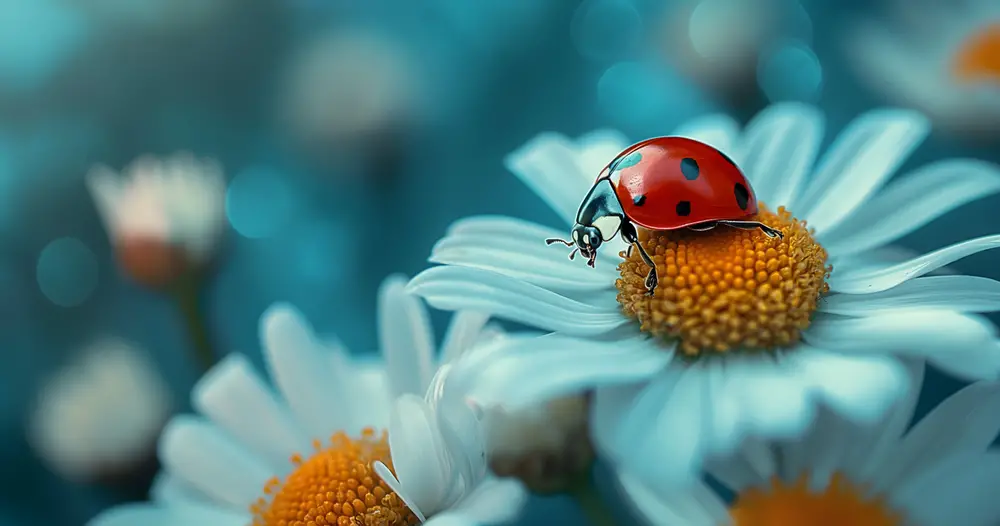
Q: Are Ladybugs Good Or Bad For Your Garden?
A: Good!
Also known as Ladybirds in certain parts of the world (like the UK where I come from!), Ladybugs are a gardener’s secret weapon. These beautiful little creatures are a powerhouse in garden pest control.
They are well-known for their distinctive, often red and black, spotted shells, making them a favorite for children’s fancy dress costumes!
Aphids are their primary food source. Aphids are, as most gardens will have at some point encountered, a nightmare in the garden and home. I once went away for the weekend and came back to find my 20 tomato plants destroyed by aphids.
The good news is that a single ladybug can consume hundreds of aphids in a week! In addition to aphids, ladybugs also eat other soft-bodied insects such as:
- Mealybugs
- Mites
- Scale insects
They are definitely a gardener’s ally in natural pest control!
They also like to eat plant matter like pollen and nectar, especially during their larval stage. This diverse diet not only helps maintain ecological balance but also supports healthy plant growth and pollination.
So ladybirds are both a beautiful and beneficial addition to the garden.
Japanese Beetles (Popillia japonica)
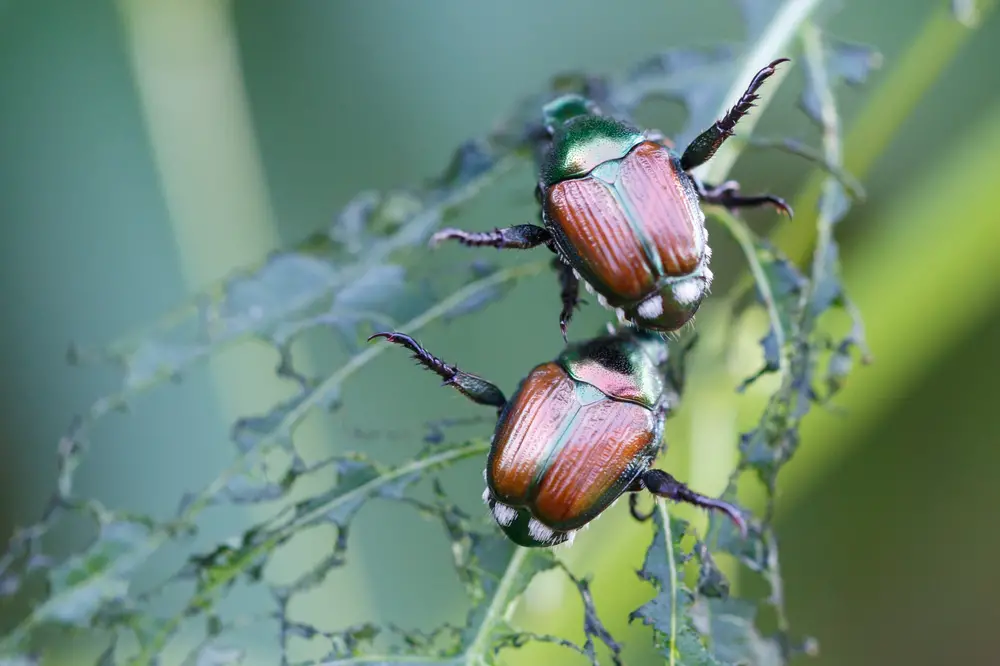
Q: Are Japanese Beetles Good Or Bad For Your Garden?
A: Bad!
The complete opposite of the friendly ladybug, these are notorious garden pests known for the significant plant damage they cause. They feed on the leaves, flowers, and fruits of lots of different plants, such as:
- Roses
- Grapes
- Hops
- Fruit trees
These little critters are prolific eaters, by stripping the plants they weaken them and make them more susceptible to other diseases. They usually do all of their eating during the day and nest at night, so at least you have a better chance of spotting them.
Originally from Japan, hence the name, they were first identified in the United States in the early 1900s and have since become widespread in Europe.
They are a type of scarab and have iridescent green and copper-colored bodies.
They are destructive in all stages of their life cycle. In the larval stage, they burrow into the soil and feed on grass roots. Adults feast on leaves, stripping them bare, and they also eat fruit.
The larvae are vulnerable to milky spore, so that is an option for pest control at that stage. While some recommend using traps to mitigate these pests and you’ll find them for sale online and in garden centers, studies suggest they attract more than they actually catch!
Natural predators like nematodes and some wasps like the solitary Tiphia vernalis, have been successfully used to get rid of this type.
Colorado Potato Beetles (Leptinotarsa decemlineata)
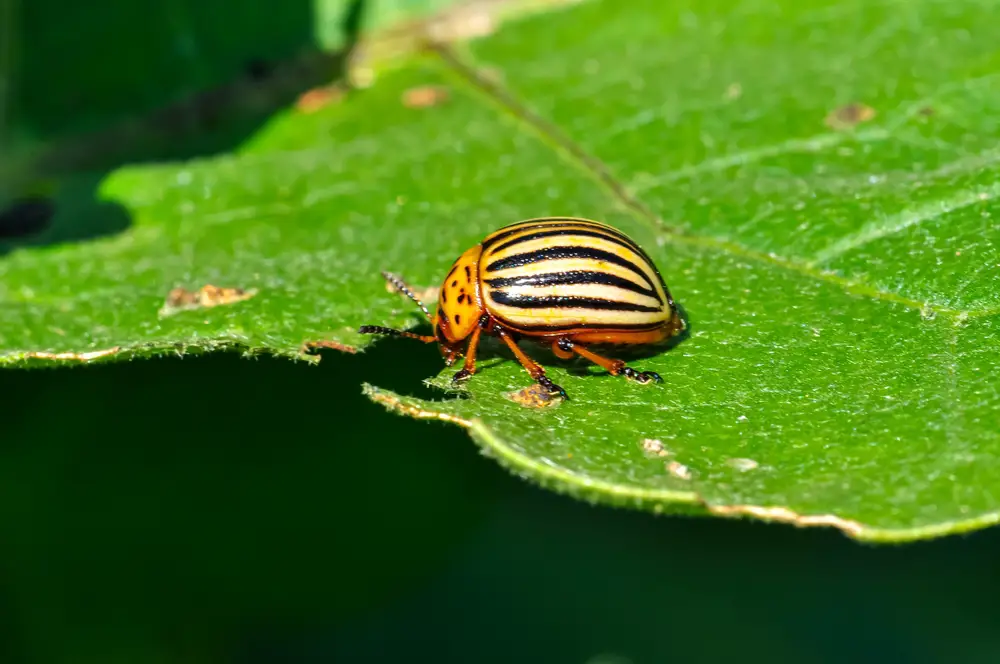
Q: Are Colorado Potato Beetles Good Or Bad For Your Garden?
A: Bad!
This is another problem bug. They are easily recognizable by their yellow-orange body and black stripes, and they pose a serious threat to potato and tomato crops.
Originating in North America, they spread to Europe in the mid-1800s. This bug is super destructive in all stages of its life cycle. Adults feed on the leaves of plants and even the larvae can be equally destructive.
Their favorite food is the nightshade family, so their prime targets are:
- Potatoes
- Tomatoes
- Peppers
- Eggplants
Due overuse of chemical insecticides along with their adaptability means they have developed resistance to many common insecticides.
Gardeners and farmers must use other strategies such as crop rotation, resistant plant strains, and biological control methods such as natural predators like the ground beetle L grandis, some lacewings, and shield bugs.
Soldier Beetles (Cantharidae)
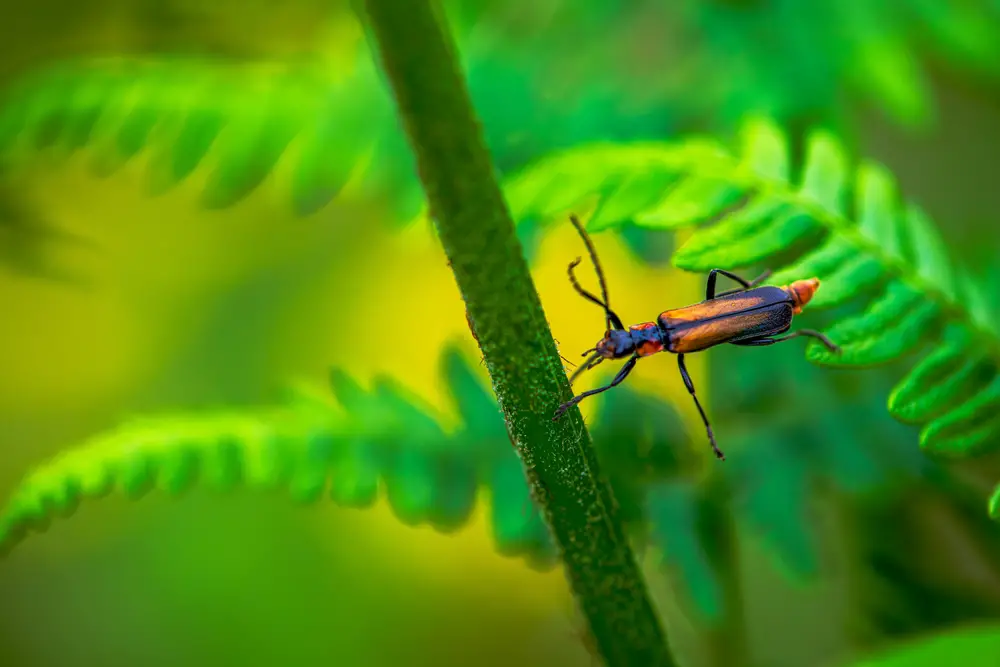
Q: Are Soldier Beetles Good Or Bad For Your Garden?
A: Good!
Also known as leatherwings, these can be recognized by their elongated bodies with orange heads and velvety, blue or brown bodies. These lovely little things play a beneficial role in the ecosystem.
Their life cycle includes both larval and adult stages. Larvae usually live in the soil, where they eat pest insects.
What do soldier beetles eat?
- Pollen
- Aphids
- Nectar
- Mites
- Mealybugs
- Small caterpillars
In other words, they are fantastic for natural garden pest management!
You’ll usually see them in your garden during summer, which is the perfect time for them to help control populations of harmful pests on your vegetables.
Do They Do Damage To Plants?
No!
As well as being predatory to unwanted pests, they are fantastic pollinators. They enjoy feeding on nectar and pollen so are very beneficial in this way.
How To Attract Soldier Beetles To Your Garden
You definitely want to attract these little garden helpers! You can do so by providing friendly habits with native plants and grasses. Things to include:
- Pollen
- Nectar flowers
- Yellow flowers
This helps increase their populations and contributes to a healthier ecosystem.
Wood-Boring Beetles
Powderpost Beetles (Lyctinae)
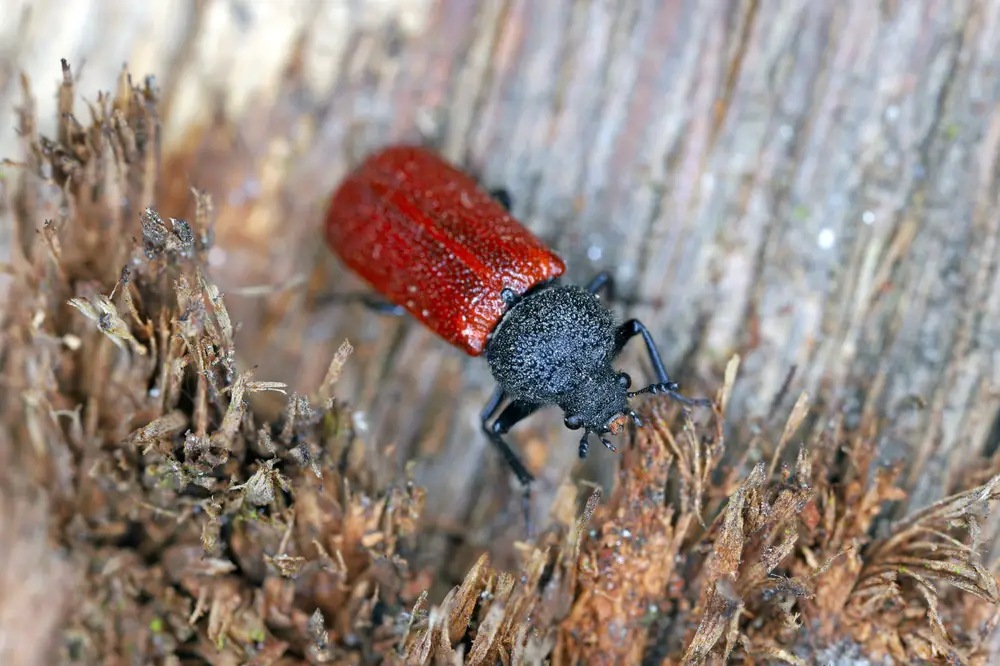
Q: Are Powderpost Beetles Good Or Bad For Your Garden?
A: Bad!
These are small wood-boring insects that have an amazing ability to destroy wood. They come in second to termites for having the most destructive feeding habits.
It is actually the larvae that do the most damage as they eat their way through the wood as they develop. On living trees, they eat the soft outer layers of wood known as sapwood. But they also like to eat hardwoods and products made from hardwood, such as:
- Oak
- Hickory
- Ash
- Walnut
- Cherry
- Bamboo
They can structurally compromise wooden furniture, flooring, and even supporting beams. They are the enemy of any carpenter!
The adults create tiny holes in wood as they emerge, and leave behind a fine, floury, dusty powder, hence their name. The adults are less destructive, their diet also consists of nectar and pollen.
Unfortunately, infestations are usually only discovered by the powder the adults leave, which means the larvae have already done the damage to the wood internally. The adults are rarely seen as they can take up to 5 years to emerge and tend to be nocturnal.
There are three types that are the most problematic:
- Lyctids
- Anobiids
- Bostrichids
Managing infestations first means correctly identifying them. They are often mistaken for other insects such as flour, cigarette, and sawtooth beetles and even weevils. These tend to go for food products rather than wood.
Prevention is the best method. Try controlling moisture levels, as they thrive in damp conditions. Wood that is treated is less likely to suffer infestation problems. So stain, paint, or varnish your wood.
Contact a professional if you suspect an infestation in anything structural or load-bearing.
Bark Beetles (Scolytidae)
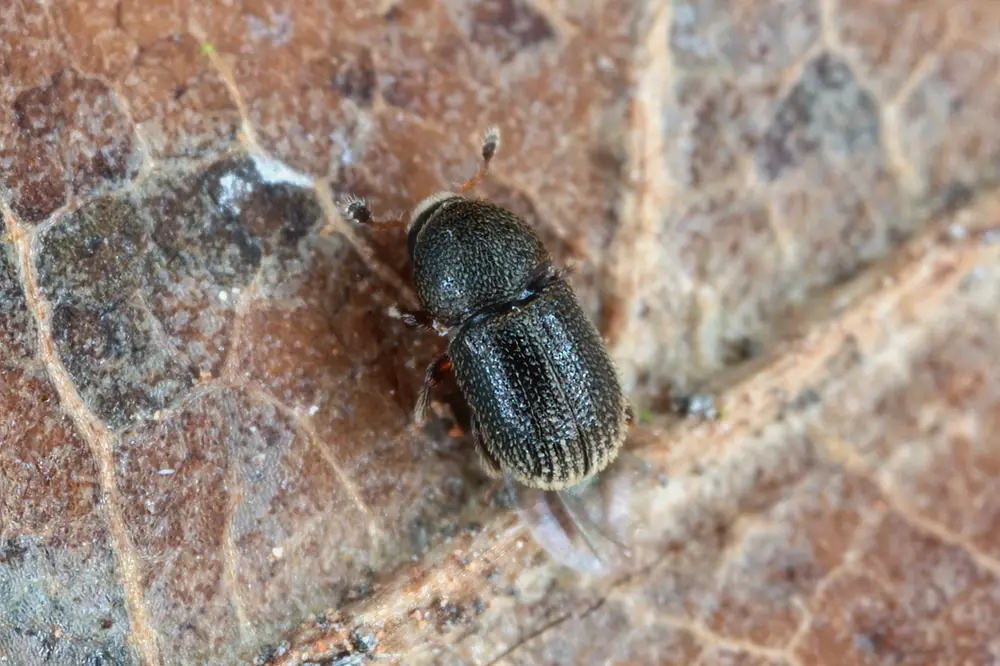
Q: Are Bark Beetles Good Or Bad For Your Garden?
A: Bad!
These are another notoriously destructive garden pest. They mainly attack trees by boring into their bark, hence their name. These pests feed on the living layer of tissue between the bark and the wood.
They are particularly problematic in North America. Outbreaks have affected and killed millions of acres of woodland and forests since the late 1990s.
There are many different types, but their primary diet is:
- Pine
- Fir
- Cedar
- Spruce
However, some types go for other trees, such as Elm and Cypress.
Adults lay their eggs on the inner side of the bark. Like powderpost, it is the larvae that do the most damage. They feed on the living tissue of the bark which can often result in the death of the tree.
These pests and fungal pathogens go hand-in-hand which further puts the trees at risk of death.
These garden pests tend to favor weak and unhealthy trees. So, ensure your trees stay in optimal health with consistent watering and pruning and dead or broken limbs. Sometimes, if the infestation is too severe the infected trees have to be removed.
A tree’s best defense is sap production. Sap can contain natural insecticides and fungicides that kill off pests. Furthermore, the sap works to heal wounds and holes inflicted by them. So, for sap production, overall tree health is paramount.
Woodpeckers are natural predators of these bugs, so encourage them to visit your garden.
Predatory Beetles:
Ground Beetles (Carabidae)
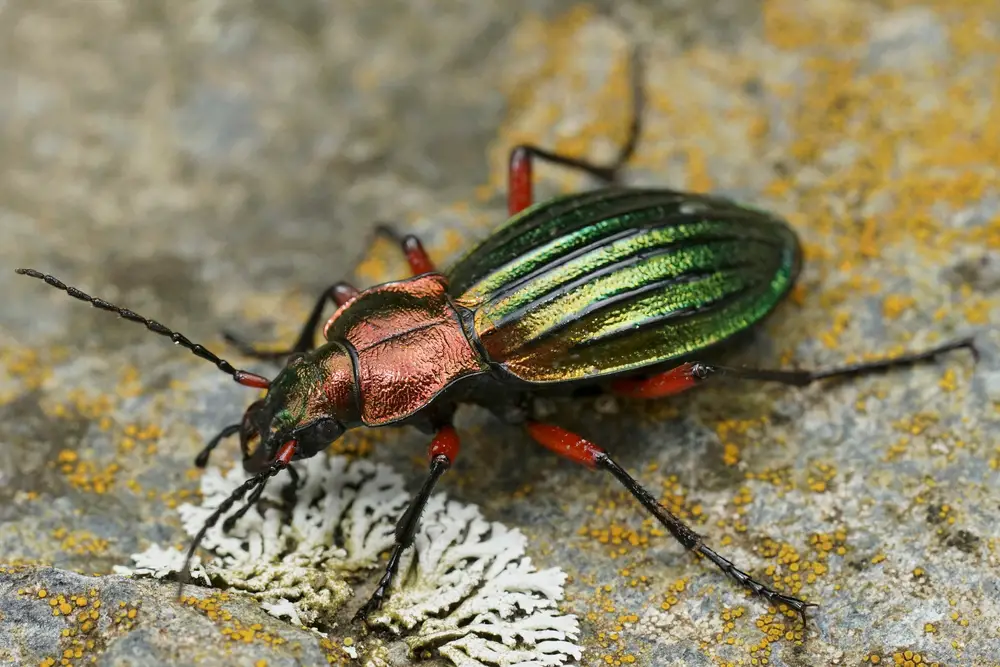
Q: Are Ground Beetles Good Or Bad For Your Garden?
A: Good!
There are many different types, in fact, there are over 34,000 different species! These are fearsome predators and can consume their own body weight daily.
They have long bodies and come in a variety of shiny colors such as black, brown, and iridescent blue and green. They have very strong mandibles for munching on their prey and they can run very quickly.
Their diet consists of:
- Slugs
- Worms
- Maggots
- Ants
- Aphids
- Caterpillars
- Grubs
They also eat leaves, and seeds, and find weeds delicious. They truly are a gardener’s BBF – best beetle friend!
Mainly nocturnal, they spend their days under plant debris or in soil and crevices. So make sure not to clean up all their habitat.
Avoid using chemical pesticides which also wipe out beneficial insects and pollinators. They favor clay over sandy soil.
Avoid the desire to tame every outdoor space and have it neat and tidy! While this is nice in some places, leave some scattered leaves, mulch, and ground cover around for them and other insects to hide under.
They are beneficial predatory insects that play a vital role in controlling garden pests. So they are our allies!
Rove Beetles (Staphylinidae)
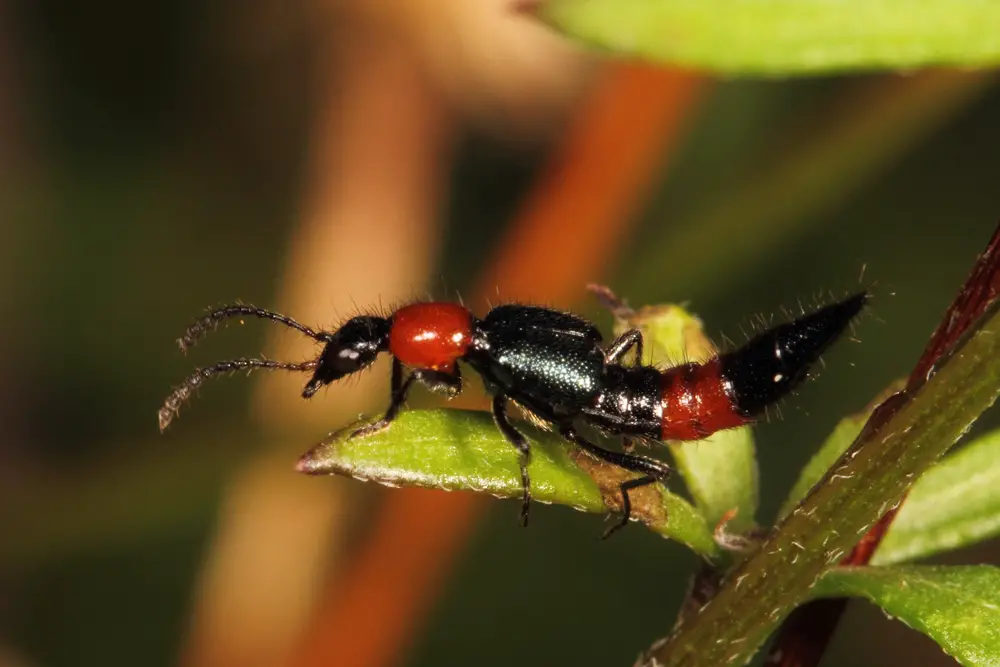
Q: Are Rove Beetles Good Or Bad For Your Garden?
A: Good!
This is the largest family in the order with over 66,000 different species. They are a friend to gardeners and farmers because they help control unwanted garden pests. In fact, one species can even be bought as a pest control solution for greenhouses!
They have long, shiny black segmented bodies. Their powerful mandibles protrude from their heads. Mainly nocturnal, these predators like warm weather but can tolerate colder climates.
Their diet consists of:
- Mites
- Mealybugs
- Thrips
- Nematodes
- Aphids
- Mosquito larvae
- Small caterpillars
- Carrion
Some species also feast on plant matter.
These insects are found all over the world in moist environments. They have even been found on top of the water far from land. Like ground beetles, they like to nest and hide in debris such as leaf litter, decaying fruit, washed-up plant material by rivers, lakes, and seas, and even in nests of other animals.
Because of their fondness for all things decaying on the ground, they play a significant role in promoting soil health. They do this by aiding decomposition and nutrient cycling.
Establish a healthy, organic environment in your garden with lots of readily available organic matter. This will attract these beneficial insects and enhance the ecosystem.
Beetles’ Impact on Gardens
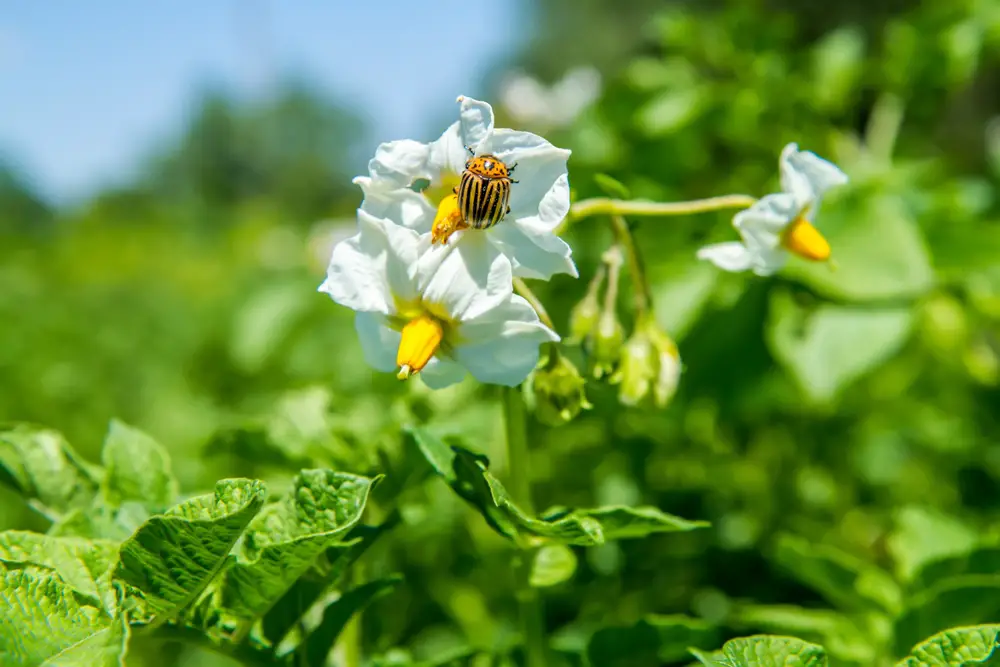
Beneficial Beetles:
The types that you want in your garden are the ones that help control garden pests and contribute to pollination. These are ladybugs, ground, and soldier beetles.
Pest Beetles:
The types that you certainly don’t want are the ones that cause damage to plants. So Colorado potato, powderpost, and Japanese beetles are definitely unwanted visitors.
Identifying signs of beetle damage in your garden by following these steps:
- Look for leaves that have been stripped
- Leaves with just the veins left
- Fruit that has been eaten
- Pay particular attention to plants that are known to be favored such as potatoes, tomatoes, and hops
Then you need to identify which type you have and take the appropriate action for that species. Read on for some more tips on how to manage these unwanted visitors.
Managing Beetles in Your Garden

As we covered before, not all types are bad. Some, like ladybugs and soldier beetles, you really want to visit your garden. Others, you’d rather they kept on moving.
So, it’s essential to identify which one you have.
Encouraging beneficial types by planting native plants, flowers, and grasses is a great way to use these predatory insects for garden pest control. Avoid using any chemical pesticides. They are not good for the ecosystem and they kill many other beneficial pollinators, such as bees and butterflies.
Other ways to mitigate against unwanted ones are:
- Crop rotation: avoid planting the same vegetables and plants in the same place each year. By moving and rotating their placements, populations of unwanted pests are less likely to develop and become unmanageable
- Plant beetle-repellent plants: for example, plants like chrysanthemums, marigolds, and garlic work to repel problematic types
Mechanical and Physical Controls:
Other choices are:
- Row cover: this prevents them from reaching the plants while allowing sunlight and water to penetrate
- Traps: be careful with these though, as it is suggested that they attract more than the catch!
- Handpicking and removal: works on small populations
- Soapy spray: combine mild liquid dish soap with water and spray plants
- Neem oil: dilute neem oil with water before application. Use it as a foliar spray or soil drench. You can also buy pre-made neem oil sprays for plants
Beetle Food Sources In The Wild
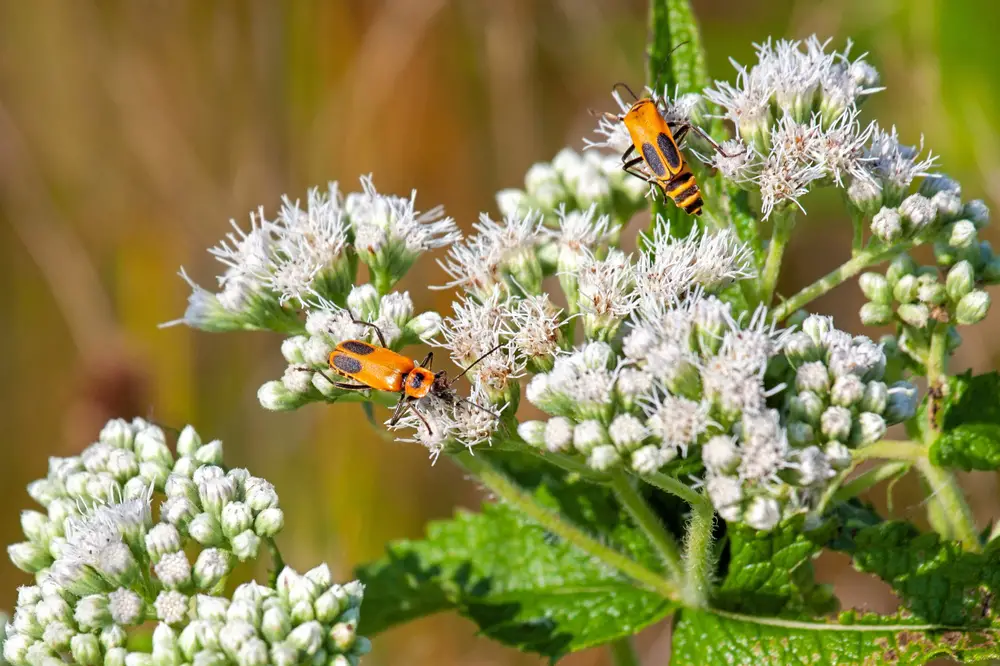
Before these insects found your vegetable garden they roamed around eating the available flora and fauna. Again, beetle food sources in the wild really depend on where in the world they live.
In forests and fields, their diet consists of plant matter, fungi, other insects, and wood material.
In the desert, their diet consists of other insects, plant matter, carrion, and often dung from other carnivorous animals.
Like most living creatures in the wild, there are seasonal variations in beetle food sources. For example, you’re likely to see more soldier beetles in the summer when other insect populations, such as aphids, are high.
Their diets will consist of more nectar and pollen when the wildflowers are in bloom from spring through to fall. In the winter they may rely more heavily on fungi, decaying plant matter, and other insects as food sources.
Create A Beetle-Friendly Garden
While some types can be a nuisance, there are many that are advantageous to gardeners, so it’s worth encouraging these fascinating insects into your garden.
They are amazing pollinators and work as a natural pest control management system.
A few things you can consider implementing in your garden are:
- Habitat: leave debris such as leaf litter as hiding spots and nest sites
- Mulch: they like warm, moist environments
- Food: provide flowering plants rich in nectar
- Native species: plant native grasses and wildflowers
- Go organic: avoid use of commercial chemical pesticides to protect these insects and promote healthy ecosystems
By creating a beetle-friendly environment, you’ll not only enhance your garden’s health but also encourage the incredible diversity of these little creatures!
